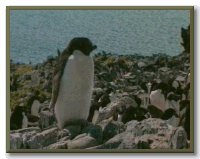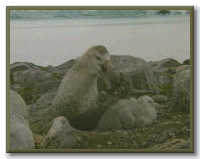Birds (please note that while penguins are birds, we've given them their own section of the website because of their inherent interest! You can jump to that section after a general introduction to the entire bird species.)
Each spring the coast of Antarctica awakens with the return of millions of seabirds to breed. Their arrival is a dramatic end to the long dark polar winter. First to arrive are the Adelie penguins, who have walked, often up to 50km, across the sea ice to reach their nesting grounds. The petrels and skuas arrive soon after, flying in from the open sea. Most of the established breeding birds return to the same nest site and to the same mate. When necessary, the site is cleared of snow and the pair bond re-established before the new breeding season begins. (See the great sequence of Adelies scavenging rocks to build their nests as seen in program 4.)
|
|
|
The numbers of birds breeding around the rocky coastline and the offshore islands are enormous, 100 million or more individuals. Most of these are Adelie penguins. Other birds include three more species of penguins, several species of petrels, a skua, a gull and a tern.
The sub-Antarctic islands to the north also are invaded in spring by seabirds. Although the species are generally different from those breeding on the Antarctic continent, they are very closely related and include penguins, petrels and skuas. These islands are also the home of the albatrosses, the largest, most spectacular and perhaps the most beautiful of all sea birds.
|
|
WANT TO LEARN MORE?
|
|
|
Websites
• Antarctic petrel Information including taxonomy of the Antarctic petrel. • South polar skua Information on the South polar skua includes taxonomy information. • Southern giant-petrel Facts about the Southern giant-petrel including taxonomy. • Prehistory More background information on the prehistory of Antarctica. • Antarctic Adventure 1997 Information on the geography and climate of Antarctica. |
|
![]()

